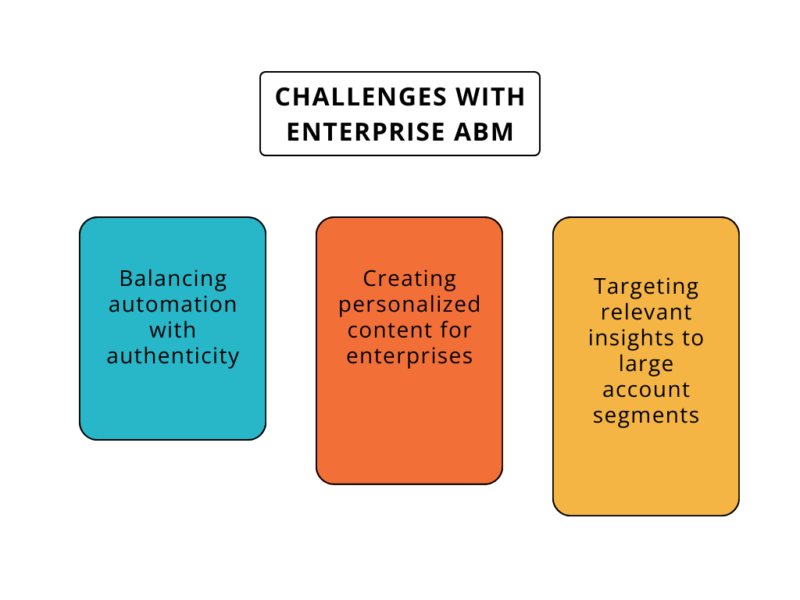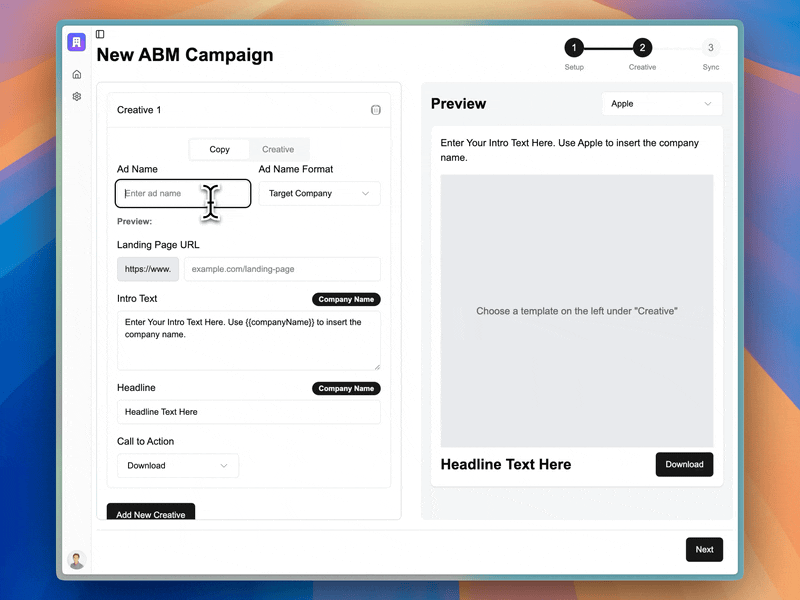Account-based marketing (ABM) can be daunting to marketers who are new to this strategy. This is especially true for large organizations with many accounts, large data loads, and countless resources.
Fortunately, there are many ways to scale an ABM campaign. For example, Karrot.ai offers an opportunity to scale ad personalization and includes tools to target accounts in one place.
Here’s why scaling ABM in large organizations can help to solve these obstacles.
Key Highlights
- Large organizations implementing ABM at scale report 208% higher revenue growth than those using traditional marketing approaches
- 97% of marketers report that ABM delivers a higher return on investment than other marketing strategies
- Personalization at scale is the primary challenge for 78% of enterprise ABM practitioners
- Cross-functional alignment between marketing, sales, and other departments is essential for enterprise ABM success
- Technology integration across the martech stack enables seamless data flow and campaign execution
- AI-powered tools like Karrot.ai solve the personalization scale challenge through automation
- Centralized governance with distributed execution creates the optimal balance for enterprise ABM
- Phased implementation approaches enable the successful scaling of ABM programs
TABLE OF CONTENTS:
Challenges With Enterprise ABM

Large organizations struggle with these common ABM obstacles:
- Targeting relevant insights to large account segments
- Creating personalized content for enterprises
- Balancing automation with authenticity
Even with these challenges, ABM is worth the investment. This strategy, coupled with aligning sales and marketing, can increase revenue by 208%.
The Scale-Personalization Paradox
Enterprise ABM programs face fundamental problems when personalizing their content at scale:
- Scale requirements: Need to target hundreds or thousands of accounts.
- Personalization imperative: Necessity for account-specific relevance.
- Resource constraints: Limited team capacity for manual personalization.
- Consistency demands: Requirements for brand and message alignment.
- Complexity management: Orchestration across multiple teams and channels.
This paradox is the need for personalized and scalable ABM strategies. With AI, enterprises can personalize ABM strategies for many accounts without compromising quality.
Common Enterprise ABM Strategy Obstacles
In addition to larger campaign problems, major organizations also struggle with smaller strategies within ABM. Here are these specific challenges:
- Resource limitations: Insufficient capacity for manual personalization.
- Unifying sales and marketing: Both teams may work on separate goals.
- Organizational silos: Disconnected teams and competing priorities.
- Technology fragmentation: Disconnected systems and data sources.
- Governance complexity: Balancing control with execution speed.
- Measurement challenges: Connecting activities to business outcomes.
- Budget allocation: Enterprises have significant marketing investments, but don’t spend them wisely.
These obstacles explain why many enterprise ABM programs struggle to achieve their potential despite significant investments.
The Enterprise ABM Framework
Solving account pain points and accomplishing your ABM goals is possible for enterprises, but it requires a structured framework that addresses their challenges. Here’s how to create a scalable framework for ABM.
Tiered Implementation Model
Organizations that implement a multi-tiered ABM framework experience 32% higher revenue. Here’s a sample when implementing a tiered ABM approach:
| Tier | Characteristics | Approach | Resource Allocation |
|---|---|---|---|
| Tier 1 (Strategic) | Top 50-100 accounts, highest value | 1:1 personalization | 40% of resources |
| Tier 2 (Targeted) | Next 100-500 accounts, high value | Segment-based personalization | 30% of resources |
| Tier 3 (Scale) | Remaining 1,000+ accounts, moderate value | Automated personalization | 30% of resources |
This tiered approach ensures resources are allocated according to account value while enabling coverage across the entire target list.
Centralized-Distributed Balance
Enterprises will only be successful at ABM if they create deep connections with all accounts, regardless of how many they’re targeting. The key to achieving this is with balance. Here’s an example of an optimal organizational structure:
Organizational Model:
– Central ABM Center of Excellence
– Strategy and Planning
– Technology and Data
– Creative Direction
– Measurement Framework
– Best Practice Development
– Distributed Execution Teams
– Regional Implementation
– Industry-Specific Execution
– Product-Focused Campaigns
– Channel-Specific Activities
This balanced approach ensures consistency and efficiency while enabling adaptation to specific market needs.
Strategy 1: Implement Scalable Personalization
The core challenge of enterprise ABM is achieving personalization at scale. Here are some ways to alleviate these problems and how to use AI for scalability.
Modular Content Architecture
Use automation to develop a modular approach to content creation. Here are ways to do this:
- Master templates: Core designs with personalization zones.
- Content modules: Interchangeable components for different segments.
- Dynamic elements: Specific areas for account-level personalization.
- Rules-based assembly: Automated content construction based on attributes.
- Quality assurance framework: Systematic review of generated content.
Personalization Hierarchy
Establish a clear hierarchy of personalization elements by following these steps:
- Account name: Basic personalization with company identification.
- Industry context: Sector-specific messaging and examples.
- Business challenges: Content addressing specific pain points.
- Solution relevance: How offerings address particular needs.
- Competitive positioning: Differentiation against specific alternatives.
This structured approach ensures personalization efforts focus on the elements with the highest impact rather than attempting to customize everything.
The Karrot.ai Solution

Karrot.ai specifically addresses the personalization scale challenge through:
- AI-powered content generation that creates account-specific variations.
- Automated personalization across thousands of accounts.
- Dynamic creative optimization based on performance data.
- Template-based consistency that maintains brand standards.
- Integrated personalization across multiple channels.
This AI-driven approach enables true 1:1 personalization at enterprise scale without proportional increases in resources or complexity.
Strategy 2: Create Cross-Functional Alignment
Enterprise ABM requires alignment across sales and marketing teams. How can enterprises align sales and marketing? This is done with shared goals, concrete ICPs, and a combination of personalization and outreach. Here’s a breakdown of this strategy.
Organizational Alignment Framework
Implement a structured alignment between sales and marketing. Here’s an example of a framework you can create:
Alignment Framework:
– Executive Sponsorship
– Shared Objectives and KPIs
– Defined Roles and Responsibilities
– Collaborative Workflows
– Joint Planning Processes
– Integrated Technology Systems
This multi-level framework ensures alignment at all levels, not just surface-level coordination.
Account-Based Operating Model
Develop an account-centric operating model encompassing sales outreach, marketing personalization, and account targeting. Here are tactics to include in this model:
- Joint account selection: Collaborative targeting process.
- Shared account plans: Unified strategy for each key account.
- Integrated account insights: Combined view of account information.
- Coordinated account engagement: Synchronized outreach across functions.
- Unified account measurement: Shared view of account progress.
This account-based model ensures all functions work together toward account objectives rather than pursuing separate goals.
Governance Structure
Implement appropriate governance mechanisms using these steps:
- ABM steering committee: Cross-functional leadership group.
- Clear decision rights: Defined authority for different decisions.
- Escalation pathways: Process for resolving conflicts.
- Regular coordination forums: Structured communication channels.
- Performance review process: Joint accountability for results.
This governance approach balances the need for coordination while executing tactics quickly.
Strategy 3: Integrate Technology and Data
Enterprises can better execute ABM with a large tech stack supporting multiple campaign areas. Here’s how to implement technology into ABM and which tools to use.
Integrated Technology Architecture
Develop a comprehensive technology stack, such as this one, to better target your most valuable clients:
| Technology Layer | Components | Integration Points |
|---|---|---|
| Data Foundation | CRM, Data Warehouse, Customer Data Platform | Account and contact information |
| Engagement Platforms | Marketing Automation, LinkedIn, Display, Email | Campaign execution and tracking |
| Personalization Engine | Karrot.ai, Dynamic Content Platforms | Creative and message customization |
| Analytics Systems | Attribution, BI Tools, Dashboards | Performance measurement and insights |
| Orchestration Layer | ABM Platform, Integration Tools | Cross-platform coordination |
Unified Data Model
Implement a consistent approach to analyze data more efficiently. Here are some tips to achieve this:
- Account hierarchy standards: How parent-child relationships are managed.
- Contact role taxonomy: Consistent stakeholder categorization.
- Engagement definition framework: Standardized interaction measurement.
- Attribution model alignment: Ensuring your framework matches your goals.
- Reporting consistency: Regular segmentation and filtering.
This unified model ensures all systems share a common understanding of accounts, contacts, and activities.
Data Integration Requirements
To better organize your tech stack, implement these critical data connections:
- CRM ↔ Marketing Automation: Account and contact synchronization.
- LinkedIn ↔ CRM: Engagement data and audience targeting.
- Website Analytics ↔ ABM Platform: Visitor identification and tracking.
- Karrot.ai ↔ Engagement Platforms: Personalized content delivery.
- All Systems ↔ Analytics: Comprehensive performance measurement.
Integrating your tools is also an effective way to enhance your ROI; in fact, 63% of companies with an ABM program have at least a 25% ROI.
Strategy 4: Scale Content and Creative Production
Content production often becomes a bottleneck in enterprise ABM, regardless of how many accounts you’re targeting. Here’s how to scale your content and creatives.
Content Scaling Framework
A scalable content framework is one of the best ways to drive growth through paid and organic ABM efforts. Here’s an example of an approach that scales content while delivering personalized experiences and improving ROI.
Content Scaling Approach:
– Core Content Development
– Segment Adaptations
– Industry Customizations
– Account-Specific Personalization
– Stakeholder-Based Variations
This layered approach ensures efficient content development while enabling appropriate levels of customization.
Production Process Optimization
Streamline content production workflows by using this advice:
- Templatized briefs: Standardized format for content requests.
- Parallel production tracks: Simultaneous development of different elements.
- Approval workflow automation: Streamlined review processes.
- Asset management system: Centralized repository for all content.
- Reuse and repurposing framework: Systematic content adaptation.
This process also requires collaboration between humans and AI. Combining human employees and technology results in time savings of 40% to 50% on routine tasks.
Automated Content Generation
Automation simplifies and streamlines various tasks associated with content creation. Follow these steps to leverage automation for content scaling:
- Template-based generation: Automated creation from standard formats.
- Rules-based personalization: Systematic customization based on attributes.
- Dynamic content assembly: Automated combination of modular elements.
- AI-powered adaptation: Intelligent customization of messaging.
- Quality assurance automation: Systematic review of generated content.
This automated approach enables content production at scale without proportional resource requirements.
Strategy 5: Implement Phased Scaling Approaches
Successful enterprise ABM requires a methodical scaling approach. Here’s how it’s done.
Pilot-Expand-Scale Methodology
Implement a structured expansion process, such as these examples:
- Pilot phase: Limited implementation with 50-100 accounts.
- Expansion phase: Controlled growth to 200-500 accounts.
- Scaling phase: Full implementation across 1,000+ accounts.
- Optimization phase: Continuously refine your program.
- Innovation phase: Advanced capabilities and new approaches.
This phased approach ensures capabilities are validated before full-scale implementation, reducing risk and improving outcomes.
Capability Building Sequence
Develop capabilities in a strategic sequence, such as this one:
- Foundation capabilities: Account selection, basic targeting, measurement.
- Engagement capabilities: Multi-channel coordination, content strategy.
- Personalization capabilities: Account-specific messaging and experiences.
- Optimization capabilities: Performance analysis and refinement.
- Advanced capabilities: Predictive approaches, AI-powered personalization.
This sequential approach establishes fundamental capabilities before more sophisticated techniques are attempted.
Resource Scaling Model
Use these tips to implement a resource model that scales efficiently:
- Core team expansion: Strategic growth of central ABM resources.
- Distributed enablement: Training and tools for extended teams.
- Agency augmentation: Strategic use of external resources.
- Technology leverage: Increasing automation as scale grows.
- Cross-functional integration: Leveraging resources across departments.
This balanced approach ensures resource capacity grows appropriately with program scale without linear expansion of costs.
Strategy 6: Develop Enterprise Measurement Approaches
Measurement becomes increasingly complex with enterprise ABM. Large organizations must measure the success of their targeting strategies and the revenue they gain from their efforts. Here’s how to scale ABM measurement.
Multi-Level Measurement Framework
Implement a structured measurement approach, such as this one:
| Metric Level | Example Metrics | Enterprise Considerations |
|---|---|---|
| Activity Metrics | Impressions, clicks, engagement | Volume management, segmentation |
| Response Metrics | Account engagement, content downloads | Cross-channel aggregation |
| Impact Metrics | Pipeline influence, revenue contribution | Attribution complexity |
| Efficiency Metrics | Cost per acquisition, ROI | Resource allocation optimization |
This multi-level approach addresses metrics for both tactical execution and strategic impact.
Enterprise Attribution Modeling
Implement sophisticated attribution for the metrics you’re tracking, such as these:
- Account-based attribution: Focusing on account-level impact rather than individual leads.
- Multi-touch attribution: Distributing credit across all touchpoints.
- Cross-channel attribution: Connecting customer engagement across different platforms.
- Time-decay modeling: Assigns more credit to the touchpoints that lead to the largest revenue increases.
- Machine learning attribution: Advanced modeling for complex scenarios.
Performance Visualization
Develop comprehensive visualization approaches using these programs:
- Executive dashboards: High-level program performance.
- Operational dashboards: Day-to-day campaign management..
- Account journey visualization: Progress of individual accounts.
- Comparative analytics: Performance across segments and approaches.
- Trend analysis: Performance changes over time.
This multi-faceted visualization ensures different stakeholders can interpret insights, depending on their needs and responsibilities.
Case Study: Global Enterprise Transforms ABM with Karrot.ai
A global technology company faced significant challenges scaling its ABM program from 100 to 2,000 target accounts. Using Karrot.ai to power personalization at scale, they:
- Implemented a tiered approach with varying personalization levels
- Created a modular content architecture for efficient production
- Deployed AI-powered personalization across their entire account list
- Integrated technology systems for seamless data flow
- Established a center of excellence with distributed execution
The results demonstrated the power of scaled ABM:
- 187% increase in target account engagement
- 64% improvement in MQL-to-opportunity conversion
- 42% reduction in cost-per-acquisition
- 3.2X return on ad spend
- $28.4M in influenced pipeline within 6 months
- 78% of the sales team reported higher quality conversations
Best Practices for Enterprise ABM Success
To maximize the effectiveness of your enterprise ABM program, follow these proven best practices:
- Start with sales and marketing alignment to ensure all professionals are tracking the same goals
- Implement a tiered approach that balances personalization with scale
- Choose the right channels to ensure you reach your target accounts
- Build a strong technological foundation before attempting advanced capabilities
- Leverage AI-powered tools like Karrot.ai to enable personalization at scale
- Create transparent governance that balances control with execution speed
- Track comprehensive metrics that connect activities to outcomes
- Implement phased scaling rather than attempting immediate full deployment
- Establish a center of excellence to drive consistency and best practices
- Focus on cross-functional processes rather than just marketing capabilities
- Use visualizations to better track the buyer’s journey
- Continuously optimize based on performance data rather than set-and-forget
Scaling ABM in Large Organizations Is Possible With the Right Technology
Scaling ABM in large organizations represents one of the most significant opportunities for B2B marketing. Large organizations can achieve this by implementing structured approaches to personalization, alignment, technology integration, content production, phased scaling, and measurement.
It’s still common for enterprises to experience ABM obstacles. The key is addressing the scale-personalization paradox with the right technology. Karrot.ai can personalize ads at scale and assist with other strategies without increasing additional resources.
Overall, a structured framework coupled with advanced technology can create ABM programs that deliver exceptional, measurable results.




